Пищевая биотехнология. Рубрика в журнале - Вестник Воронежского государственного университета инженерных технологий
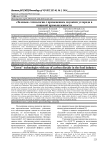
"Зеленые" технологии с применением двуокиси углерода в пищевой промышленности
Статья научная
Опыт развития социальных государств свидетельствует о наличии прямой зависимости между экономическим, социальным и экологическим развитием и инновационной направленностью проводимой промышленной политики. Иными словами, главной целью промышленной политики должно стать обеспечение высокого уровня качества жизни, социальных гарантий и экологической безопасности, достигаемое путем инновационного развития определенного комплекса отраслей. Одной из таких отраслей является пищевая промышленность. Ее главная цель на современном этапе – обеспечение эколого-социального типа экономического роста. Инновации в пищевой промышленности, приносящие экономический, экологический и социальный эффекты должны стать приоритетными при формировании инновационно-промышленной политики. Таких инноваций в пищевой промышленности России разработано достаточно много, однако инструментов для стимулирования их внедрения явно не хватает. Рассматривая вопросы инновации в пищевой промышленности необходимо учитывать, что в настоящее время главное не только цена-качество, но экологическое и социальное воздействия на потребителей...
Бесплатно
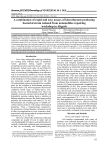
Статья научная
Routine washing, cleaning, repairing, maintenance of cars, bikes, scooters and disposal of waste of all kinds are carried out in automobile workshops are common observations in Aligarh. Considering the likelihood of existence of biosurfactant producing organisms at hydrocarbon contaminated site, a large number of soil samples were collected and isolation was carried out. A total of ten bacterial strains ALIG (01–10) were isolated out of which only isolate АLIG01 grown on GSP agar, Maconkey agar as well as on Pseudomonas agar plates which indicated suspected Pseudomonas spp. and exhibits positive biosurfactant activity through penetration assay, oil spreading technique, beta hemolytic activity and ЕI24 (96%), positive blue plate agar plate (> 2сm), qualatitative analysis, tolerance against hydrocarbon m-xylene, and microplate assay. This isolate АLIG01 is a valuable source to investigate further for future agriculture plant pathology and industrial applications.
Бесплатно
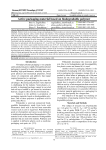
Active packaging material based on biodegradable polymer
Статья научная
Modern trends in processing, storage and packaging of food products are aimed at preserving the native properties of raw materials, ensuring hygienic safety, modern design and properties of the packaging material intended for the consumer. Pasteurized milk production includes following stages - normalization, heat treatment, packing and packaging, at which it is important to preserve the quality of the finished dairy product, that is why polymeric containers are used for most dairy products. The research was aimed to develop polymeric packaging for milk, characterized by additional material functions and capable of biological degradation after use. Polylactide with the introduction of an inert filler was chosen as a promising packaging material. The authors have produced electret films based on polylactide with the introduction of 2, 4 and 6% talc. Polarization of the samples was carried out by means of corona discharge on a unit with a square needle electrode with an area of 49 cm2. Increasing the talc content in the composition of samples contributed to the reduction of mechanical characteristics of materials. It was found that the introduction of talc into polylactide increases the electret properties of the material, which is based on the occurrence of additional traps of injected charge carriers. The developed polymeric material was tested using cow's milk industrially pasteurized at 74-76°C. Studies were conducted to evaluate the effect of electret polylactide film on acidity and microflora composition of pasteurized milk during storage at 37°C for 48 hours. In the presence of active packaging material, the formation of a dense milk clot and an increase in the acidity of the product were observed during the milk fermentation.
Бесплатно
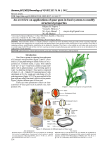
An overview on applications of guar gum in food systems to modify structural properties
Статья научная
Polysaccharides define as complex polymers composed of units interlinked with glycosidic bonds originated naturally. Polysaccharides are categorizing in several groups and among them, Gums are those with critical roles in food systems. Guar Gum is imparting softness, emulsification, stabilizing via its addition to formulas. This Gum is a fast soluble in cold water and can be active in a wide range of pH. The aim of this overview is giving an initial concept about guar gum and then convey to an introduction of its applications in food industries.
Бесплатно
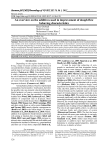
An overview on the additives used in improvement of dough flow behaving characteristics
Статья научная
Bread in all its diversity has cited as an ancient foodstuff for over 6000 years; bread dough, due to its viscoelastic behavior may consider as the most complicated rheological system which highly effects on final products’ sensorial and textural properties. Since the research dough rheology is of being challenging issues, therefore this explains why dough rheology has been an attractive title for several decades. Recently, demand to use new formula and sources such as cassava which result in enhancement of digestibility and along with it, the incorporation of aforesaid sources in cereal products, has been converted to a growingly investigation of rheological properties of dough. Substitution level of any novel sources directly effects on texture properties, even adverse affections, which evaluates by panelists therefore in this review we focus on different concepts of bread rheology and the affection of all added ingredients on physiochemical properties.
Бесплатно
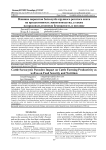
Статья научная
Cows and Bulls are mainly raised for milk and meat. Cattle Milk and meat play a vital role in the worldwide economies and contribute to food security and nutrition. For greater financial income accumulation, Cattle sourced Food products encompassing milk, butter, yogurt, ghee, cheese, Tenderized meat, meat sausage, etc. are sources of financial income for farmers and food producers. Unfortunately, Cattle Sarcocystosis disease can affect food security, and Cattle farmers’ economies by inducing reduced milk production, weight loss and decreased meat quality, abortion, and even death due to the effect these parasites have on Cattle (Hoeve-Bakker et al., 2019). Cattle Sarcocystosis disease is so far known to be specifically caused by six Sarcocystis spp infections in the Cattle. Each of the six (S.cruzi, S.hominis, S.heydorni, S.rommeli, S.hirsuta, & S.bovifelis) has its own different definitive host The two zoonoses (S. hominis & S. heydorni) share human as their common definitive host. Though the most prevalent among six bovine species, S. Cruzi, is not a zoonosis (Ayazian Mavi et al., 2020), it is a financial burden to the food producers and it may perpetuate malnutrition and Food insecurity. Therefore, Strengthened Control in Food Safety, Food biotechnology, and the Veterinary parasitological sector with the involvement of the public, civil society, and private sector are required to prevent the spread of sporocysts and protect water and Cattle Feed from Sarcocystis spp contamination.
Бесплатно
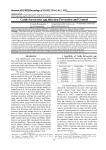
Cattle Sarcocystis spp. infection prevention and control
Статья научная
Cattle Sarcocystis spp. are protozoa. They often parasitise tissues of Cattle. Few of these species are zoonoses. Therefore, they are foodborne parasites associated with consumption of raw or insufficiently thermally treated sarcocystic beef meat. Swallowing oocysts from environmental objects primarily contaminated water, garden crops, grazing on contamited pasture, etc. can cause Cattle sarcocystosis. Sarcocystis spp specific to Cattle include S.hominis, S.heydorni, S.cruzi, S.hirsuta, S.rommeli &S.bovifelis. Among them, S.hominis and S.heydorni are zoonotic and pathogenic agents. Human Intestinal/ Muscular Sarcocystosis is a disease that caused by eating raw or poorly cooked Cattle meat infected by Sarcocystis zoonoses (S.hominis&S.heydorni). Intestinal Sarcocystosis was reported almost from all corners of the world. This has been well documented but no powerful Preventive and control methods available to public yet. With the world growing population, researchers should provide or suggest practical solution to supply safe food to the consumers. During our research work we tried to compare the effectiveness of all available documented Cattle sarcocystis spp. Testing methods to recommend the best one to the public for screening health from infected Cattle before slaughter in the slaughter house. Though culture and society play a fundamental role in foodborne control, we also came up with additional control safety measures recommendations all along the beef meat supply chain.
Бесплатно

Статья научная
Results of international comparative interlaboratory tests on defining contents of nitrogen oxides (NO, NOx) in gaseous phase of aerosol of heated tobacco products are presented in the article. The objects of study were samples of heated tobacco intended for use with electric tobacco heating systems of the IQOS, Glo and Ploom brands. The determination of nitrogen oxides in the gas phase of aerosol from heated tobacco products was carried out using a technique developed in the laboratory of chemistry and quality control of the Federal State Budget Scientific Research Institute “All Russian research institute of tobacco, makhorka and tobacco products”. The aim of interlaboratory comparative tests is calculation of intra- and interlaboratory variability (repeatability and reproducibility). Mandel h and k statistics were utilized for statistical compatibility analysis. Analysis of interlaboratory compatibility was carried by z - index, statistical identifying of outliers was carried by Cochran’s and Grubbs’ criteria. Also, repeatability and reproducibility were calculated. Statistical analysis of interlaboratory comparative tests results proved high level of validity of obtained data. Establishing metrological characteristics is a key aspect of ensuring the reliability and applicability of the methodology. Interlaboratory comparative tests for nitrogen oxides defining are the first time carried in Russia and are actual for innovative products from heated tobacco.
Бесплатно
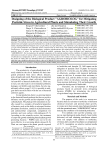
Статья научная
The results of the selection of new plant growth-promoting bacteria resistant to herbicides of different chemical structure are presented. Two methods were used for screening: sowing on microbiological media from freshly sampled soil and obtaining enrichment cultures from soil samples exposed to herbicides for a month at a temperature of 28 °C. Inoculation was carried out on selective nutrient media containing herbicides Octapon extra (2,5 g/l), Florax (2,5 g/l), Dicamba (1 g/l), Nanomet (1 g/l), Spetsnaz (1 g/l) or Chistalan (2,5 g/l). These herbicides are commonly used to control weeds in wheat crops. The isolated microorganisms belong to the genus Pseudomonas, fix nitrogen, mobilize phosphates, synthesize phytohormones and antimicrobial compounds. They also can mitigate pesticide stress of crops. An anti-stress biological product containing them has been developed and tentatively named "AGROBIOLOG". For its production, the optimal composition of the nutrient medium and the conditions for industrial submerged cultivation on reactors of various volumes were determined. In the laboratory fermenter FA10 with a volume of 10 liters after 72 hours of cultivation at a temperature of 28 °C, a stirrer speed of 200 rpm, aeration of 0.5 volumes of air per 1 min per 1 volume of medium, the amount of viable cells was 28 billion CFU/ml of culture liquid. Cultivation on biological reactors with a volume of 1000 liters under the same conditions allowed to achieve a titer of 6.0 billion CFU/ml of culture liquid.
Бесплатно
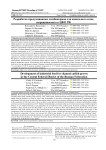
Статья научная
In the result of the analysis of domestic experience over the last 10 years of foreign experience (for example, 9 countries: Vietnam, India, Spain, Canada, China, Norway, USA, Chile, Japan, which possess the most advanced technologies and equipment for highly efficient production of feed for fish) in the development of innovative technologies and equipment for production of high-performance fish feeds were identified that the methods both dry and wet pressing are outdated and do not meet modern requirements in the production of fish feeds since it does not allow a deep physical-chemical transformations in protein-carbohydrate complex and exercise enter fat components at 40 %. Modern fish technologies are based on the use of extrusion processing of multicomponent mixture to give different buoyancy and adjustable rate of immersion of the resulting feed. Extrusion technology will allow to introduce a large amount of fat into the product - up to 35-40 %, to achieve 100 % starch splitting level. Based on the study of the nutrition of the canal catfish grown in the Central Federal District of the Russian Federation, the nutritional value of each of the components of the feed mixture, providing the need for fish to ensure a significant increase in the growth of live mass and improve the chemical composition of meat, was assessed for different age groups. To solve this problem, the "Feed Optima Expert" optimization program has developed products of extruded feed. Food needs of canal som: 30 - 40 percent protein, 4 - 6 percent fat, no more than 5 percent fiber, 35 - 40 percent Nosazotic Extract substances and 12 - 13 thousand kilos of Joule digestible energy in 1 kilogram (in recalculation on dry matter).
Бесплатно
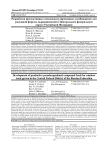
Статья научная
The decrease in catch of valuable fish species from natural water bodies is compensated by their intensive cultivation in artificial conditions. In order to realize the main task of trout farms associated with obtaining marketable products in the shortest possible period of time, artificial feed is used as a source of food. A economically feasible alternative source of raw materials is the products of plant origin. In the process of production of oil and fat products at various stages, numerous fat wastes and by-products are formed, wich have fodder value and are not used as feeding facilities in industrial scale. This is especially frue for fat processing (soapstock of Light oil, fatty bleaching clays, dezodoration chases, phosphatides, calcium salts of fatty acids), as well as waste oils in combination with fat processing waste. On the base of studying the classical technology of producing mixed fodders for valuable fish species and eliminating its drawbacks the technology of pseudocapsulated mixed fodders for salmon fish grown in the CFD of Russia Federation with given fodder value and a line for its realization is suggested. The best way to bring fats and vitamins contained in them to valuable fish species is to feed them as a part of mixed fodders. At present, however, it is difficult to increase the level of fat in feed on the existing Russian fats supply lines, since most plants can include up to 10% of fat in the bulk feed line. Therefore, the development of mixing formulations and techniques for valuable fish breeds using sturgeon fish with more than 10% fat in it as an addition of fat oily wastes such as epaulettes and phosphates is not only of scientific interest. In the course of studies optimization encapsulated optimal feeds for program "Feed Optima Expert" pseudorainbow trout were also developed. As a result, close results were obtained in terms of the rate of growth of trout, the development, conversion of feed and viability in comparison with the best feed counterparts on the Russian market.
Бесплатно
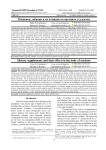
Dietary supplements and their effect on the body of students
Статья научная
The world does not stand still. We are daily confronted with the achievements of modern science: we are able to communicate with a person from another continent via the Internet, we easily bypass any distance thanks to different modes of transport. And yet there are things that cannot be automated, improved, accelerated yet. A person still needs to sleep, have some physical activity during the day and, of course, eat. The whole day of a person can easily obey the rhythm: breakfast, lunch, dinner, and, of course, snacks, afternoon tea, brunch, late dinner. And it's getting harder and harder to give up food, as store shelves are bursting with goods that are ready to lie there for years until we buy them. This is because most of the foods we consume contain various dietary supplements in their composition. The main purpose of which is to make them tastier, stored longer, etc. Undoubtedly, the nutrition of all population groups can be affected by food additives, but in this article we will consider young people: 2nd and 3rd year students. Of course, studying, writing course projects, a large number of practical and other classes deprive you of the opportunity, or rather the strength and desire, to eat right. Therefore, this age group is of particular interest. To what extent are students aware of the presence of food additives in their food? How many of the survey respondents monitor their diet? And in general: are dietary supplements as harmful as they say in the media? In this article, we will analyze the survey data of students, as well as understand what dietary supplements are and how they affect the body.
Бесплатно
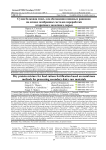
Статья научная
Protein deficiency in the diets of various determined groups of consumers is a serious nutritional problem. The problem of protein deficiency in diets can be solved by developing protein mixtures for their enrichment, taking into account trends in personalized nutrition. Whey processing using membrane technologies corresponds to the concept of Green, Circular, Bio economy. Membrane technologies make it possible to fractionate various whey components and obtain high-tech protein products. The aim of the study is to develop a basic recipe, assess the organoleptic properties and physicochemical characteristics of a dry protein mixture based on whey proteins obtained on the basis of membrane methods. Whey protein concentrate UF WPC - 80 was used as the main component of the protein mixture. Whey protein concentrate and isolate in a 6:1 ratio form the basis of the protein mixture we have developed. We offered options for expanding the range of flavoring additives for dry protein mixtures by combining traditional flavoring additives "Strawberry", "Cherry", "Apple", "Pineapple", "Melon". We have provided an optional addition of papaya and pineapple extracts in case of decreased activity of digestive enzymes, for example, in the elderly people. The technological scheme for obtaining the finished product provides for two-stages dry mixing of the components and the use of commercially available equipment. The protein mixture is a dry powder and is recommended for use in liquid form by restoring it with water, milk or natural juice, for example, veatgrass. We investigated the composition and properties of the developed dry protein mixture in accordance with official and generally recognized test methods. The developed product meets the requirements of TR CU 021/2012 "On food safety" and can be recommended to increase the adaptive capabilities of consumers of various age and physiological groups to physical and neuro-emotional stress, as a fortifying component of diets
Бесплатно
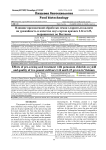
Статья научная
In this study, we conducted an experiment to evaluate the effect of pre-sowing seed treatment with 0.05% KCl to the yield and quality of two peanut cultivars L14 and L23 grown in Bac Ninh province, Vietnam. After careful selection, the seeds of L14 and L23 were divided into two parts. Part 1 (control) was treated with distilled water and Part 2 (experiment) was treated with 0.05% KCl. The field experiment was arranged in a Split-plot design with four replications. The results show that pre-sowing seed treatment with 0.05% KCl increased the yield components (weight of 100 pods, weight of 100 seeds, mass ratio of unshelled peanuts, number of pods per plant) and yield of both L14 and L23 when compared to the control, in which the yield of L14 is higher than that of L23. Pre-sowing seed treatment with 0.05% KCl also increased the quality of peanuts such as starch content, reducing sugar, lipid, saponification value, protein, B vitamins, total amino acids and content of some mineral elements in peanuts such as N, K, Ca, Mg. The results of this study demonstrate the importance of pre-sowing seed treatment for peanuts.
Бесплатно
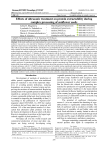
Статья научная
In this study sunflower seed cake produced on a screw press by cold pressing of dehulled sunflower seeds of confectionery-type sunflower was used as a raw material for obtaining of sunflower protein preparations. Ultrasonic treatment of the phenol-free cake was applied for improvement of extractability of proteins after the removal of phenolic compounds by treatment of dehulled sunflower press cake with an aqueous ethyl alcohol solution. Sonification was accomplished by the generator at ultrasound frequency of 22.00 ± 1.65 kНz with a duration of ultrasonic treatment from 5 to 15 minutes. Extraction of proteins was carried out in a mild alkaline medium with 0.1 % sodium bicarbonate solution with a hydro module of 1: 5 and temperature of 45 ± 2° C. Protein and dry matter content of protein extracts proportionally increased after 5-12 minutes of ultrasonic treatment with the formation of homogeneous protein extracts stable to solid phase separation and characterized by a lighter colour in comparison with the control sample not subjected to ultrasonic processing. However, after 15 minutes of ultrasonic treatment protein extracts lost uniformity with sedimentation of a solid fraction. Studies demonstrated that application of ultrasonic treatment prior protein extraction resulted in a growth of dry matter and crude protein content of sunflower protein extracts correspondently to the duration of sonification. This effect might be beneficial for an increase of protein yields in processes of manufacturing of light-coloured sunflower protein concentrates and isolates and for manufacturing of functional protein drinks from sunflower seeds. Additionally, it has been shown that sonication of sunflower protein solutions obtained after extraction of protein substances with 0.1 % NаНСО3 solution and removal of insoluble residue significantly improved their sedimentation stability and resulted in a lighter colour of resulted protein solutions in comparison with a conventional treatment by a high-speed disperser. Such treatment might be used in processes of manufacturing of dairy milk analogues from sunflower seeds.
Бесплатно
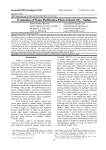
Evaluation of Water Purification Plant at Kosti City - Sudan
Статья научная
The objective of this study is to evaluate the purification level of water plant in Kosti city to supply water with high quality. This study was done to investigate the drinking water quality of Kosti city. Five sites of water network were selected, during March 2017 - May 2017. Thirty (30) samples of water from different areas of Kosti city were collected to evaluate water purification by using some laboratory tests for physical, chemical properties and microbiological. The results obtained showed that the turbidity level ranged between (4.2 – 150 NTU) thus exceeding the permissible level of WHO 1993 standards (5 NTU).The PH value was ranged between (6.3 – 8.2) and level of TDS (111 - 157 mg/L) ,hardness (43 - 89 mg/L) , residual chlorine (0.1 - 0.4 mg/L) , EC (116 - 234 μs/cm) . All these values fall below the values of national and international standards of (WHO, 1993) and Sudanese Organization for Standardization and Metrology 2008. The level of COD (86 – 584.4 mg/L), BOD (16 -144mg/L). Biological tests were conducted to determine the presence of fecal coliform the results showed that the samples of water limits according to the specifications of the Sudanese Organization for Standardization and Metrology(SOSM, 2008) and the World Health Organization (WHO, 1993) by 100%.
Бесплатно
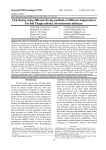
Статья научная
Тhis study was conducted at the Institute of Agricultural Engineering and Food Processing, Georg-August University, Gottening- Germany during the year 2016. The objectives of the study were to investigate the effect of drying method using three levels of drying temperatures on drying rate and drying time of fish Tilapia nilotica (Oreochromis niloticus). These methods are hot air (oven) drying; Microwave drying and infrared drying. The levels of temperatures were 40, 50 and 60˚C for each of the drying method. The results show that, there is direct relationship between drying temperature and drying rate and inverse relationship between temperature and drying time i.e. as the temperature of the drying increases the drying rate will increase and the drying time will decrease and vice versa. For oven drying method the lowest drying time was obtained at temperature of 60°C (7 hours) and the highest drying time was encountered at temperature 40°C (17 hours). Also the highest drying rate (37.232g water∕100 g of DM ∕hour) was found at temperature of 60°C and the lowest drying rate (14.936 g water∕100 g of DM ∕hour) was obtained at temperature of 40° C. When using Microwave drying method the lowest drying time was obtained at temperature of 60°C (5 hours) and the highest drying time was obtained at temperature 40° C (22 hours) and the highest drying rate (52.208 g water∕100 g of DM ∕hour) was obtained at temperature of 60°C and the lowest drying rate (11.032 g water∕100 g of DM ∕hour was obtained at temperature of 40°C. In case of infrared drying method the low drying time was obtained at temperature of 60°C (8 hours) and the highest drying time was found at temperature 40°C (14 hours) and the highest drying rate (39.589 g water∕100 g of DM ∕hour) was obtained at temperature of 60°C and the lowest drying rate (18.009 g water∕100 g of DM ∕hour) was obtained at temperature of 40°C. Statistical analysis using Eviews program show that microwave gives better results.
Бесплатно
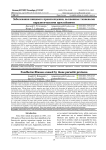
Foodborne illnesses caused by tissue parasitic protozoa
Статья научная
Zoonotic infections caused by Sarcocystis species, known as intestinal sarcocystosis, are an example of foodborne illnesses that occur due to the consumption of contaminated meat. Zoonotic Sarcocystis parasites, specifically those hosted in cattle and swine meat, have been reported as the sole causative agents of human intestinal sarcocystosis. The infection’s symptoms include nausea, diarrhea, vomiting, and abdominal pain. Talking about zoonotic parasites goes hand in hand with discussing the parasite life cycle, animals that act as natural intermediate hosts, and humans who act as the natural definitive host for the parasite. To safeguard cattle and swine meat consumers, the government of Rwanda, through the Rwanda Inspectorate, Competition, and Consumer Protection Authority (RICA), has banned the sale of meat that has not been refrigerated for at least 24 hours and reached a temperature between 2oC and 4oC before sale in order to prevent the transmission of zoonotic and transmissible diseases. Based on various literature reports, zoonotic sarcocyst viability remains intact in this range of temperatures for a period of 24 hours. Given that the prevalence of swine coccidia in Rwanda was reported to be 55.8%, Coccidia may not only include Sarcocystis species. The established rule may not be contributing to the prevention of zoonotic sarcocystis parasite infection but it is a preventive solution for many other zoonotic parasites and pathogens. Due to the lack of research reports on zoonotic sarcocystis in Rwanda, there is limited knowledge about these parasites in the country. This lack of information may explain why the prevention and control measures taken to address zoonotic pathogen infection do not adequately address the issue of zoonotic sarcocysts. Though the parasite infection was reported to be negligible, it may induce reduced human food availability in the food production system due to the ability of the disease to be transmitted from humans to cattle and pork. These later animals' meat is prestigiously served as human food in Rwanda.
Бесплатно
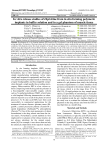
Статья научная
Development of in situ forming implants (ISFI) based on PLGA polymers is one of the most promising approaches to long-acting injectables. Evaluation of the drug release rate from such depot formulations requires methods that most closely simulate in vivo conditions. Gel phantoms mimic the elastic properties of muscle tissue and appear to be a promising replacement for conventional methods using physiologically relevant buffer solutions. Accordingly, the aim of the study was to select the optimal composition for the gel phantom formation and evaluate the effect of the phantom matrix on the release rate of rilpivirin used as a model drug from the PLGA ISFI. According to the results of the study, a 1% agarose gel was the best suited for a tissue phantom preparation and implant formation. It was also shown that the release profile of rilpivirin from the ISFI matrix depended on how the implant was formed (in a gel or freely in buffer). In the case of a phantom, the structure of the implant was less porous and retained its shape for 28 days of incubation at 37 °C. During this period, the ISFI formed in an agarose gel released considerably less rilpivirin compared to the ISFI formed without gel (11% vs 80%).
Бесплатно
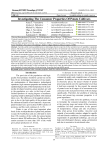
Investigating the consumer properties of potato cultivars
Статья научная
Currently, public catering establishments use technologies that do not provide for the varietal division of vegetables, in particular potatoes. This leads to excessive waste during cleaning and significant losses of nutritional value when preparing culinary products. Quick-cooking potato varieties, together with varieties of long-term processing in one culinary product, lead to the fact that half of the products are cooked, while the other half remains raw during the same time, or with longer processing. The paper considers the potato cultivars of various starch concentration grown in the central part of the country. The aim of the study is to determine the outcome of the product and the consumer properties of different potato cultivars. The objects of the investigation were the following potato cultivars: POT6 (I reproduction), POT4 (elite), POT5 (II reproduction), POT8 (II reproduction), POT3 (elite), POT12 (I reproduction), POT7 (elite), POT9 (middle early-season) and POT1 (early-season). It has been determined that POT5, POT4 and POT3 are the biggest in size (75-85 mm), but POT6 is the smallest (35 mm). But such cultivars as POT8, POT5 and POT12 are the largest in weigh (106-126 g), while POT1 and POT7 are the lightest (72 and 76 g, respectively). The potato cultivars such as POT4 (8.33%), POT12 (8.49%) and POT6 (9.1%) gave the minimum of wastes when peeling. As the investigation was carried out in April, the total amount of wastes was 5 times less if compared to the Standards of wastes and losses of food processing. It specifies the long shelflife period
Бесплатно

